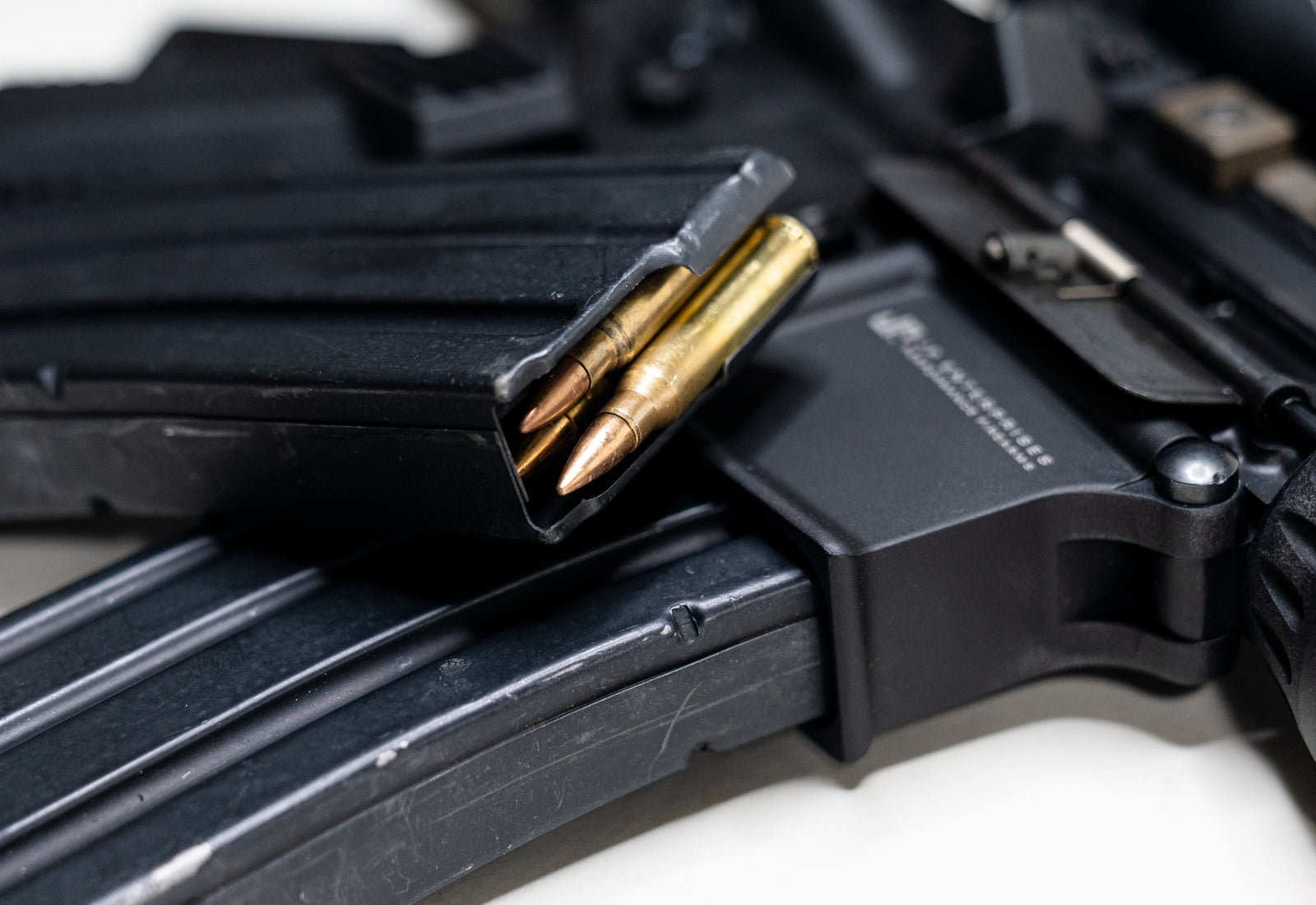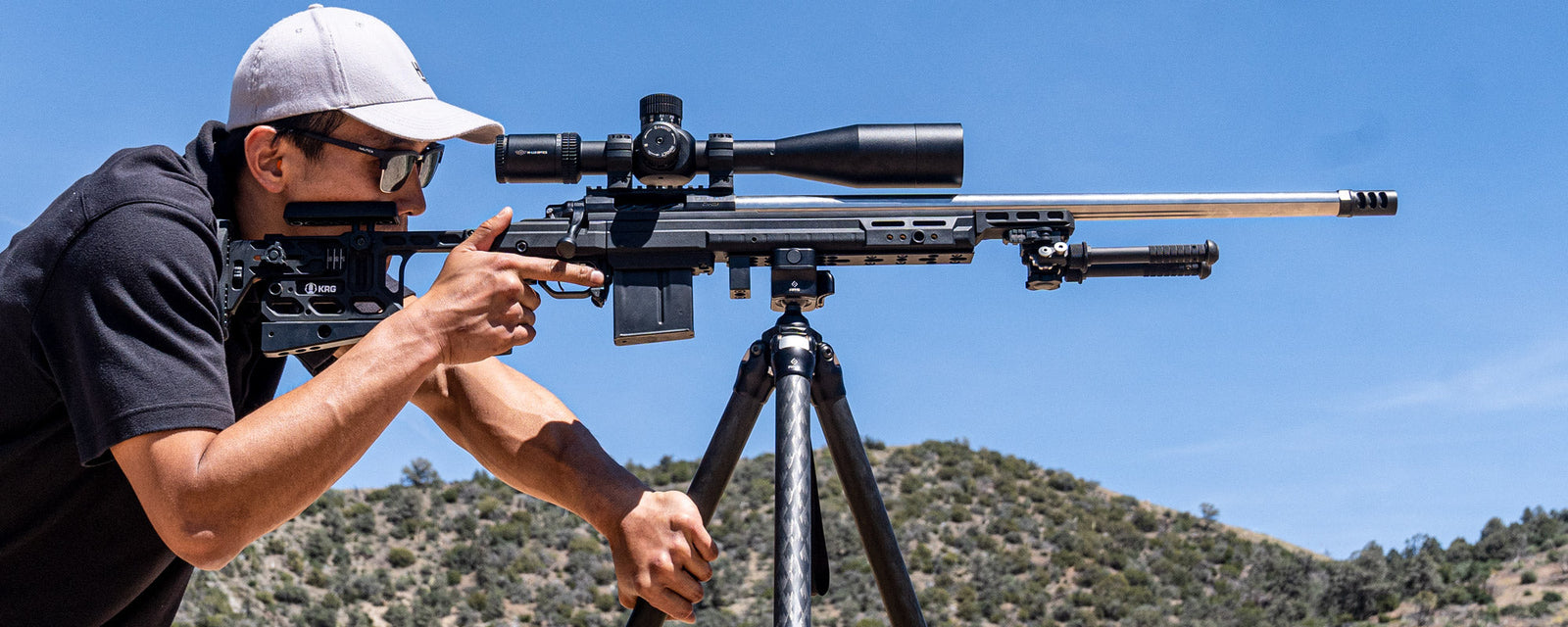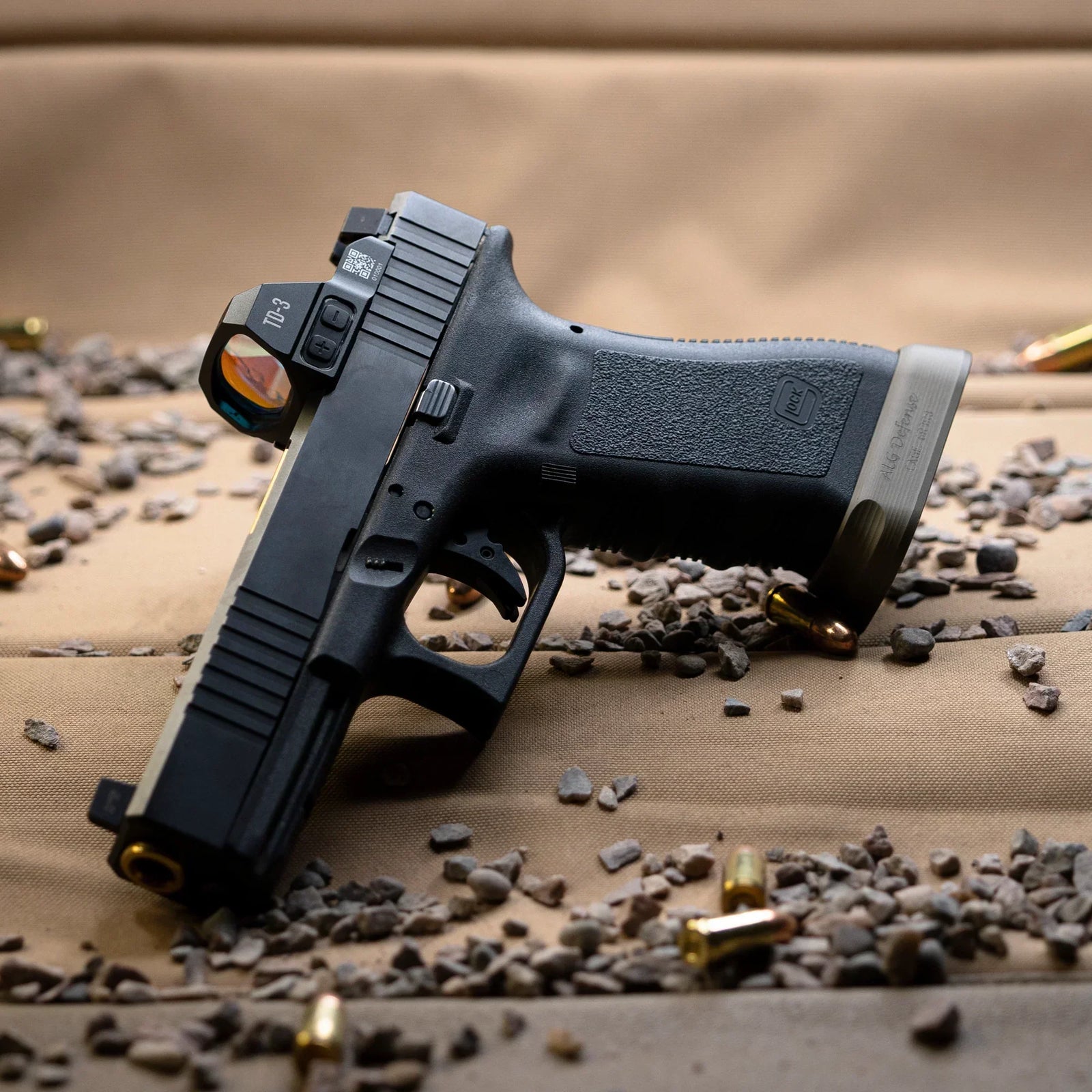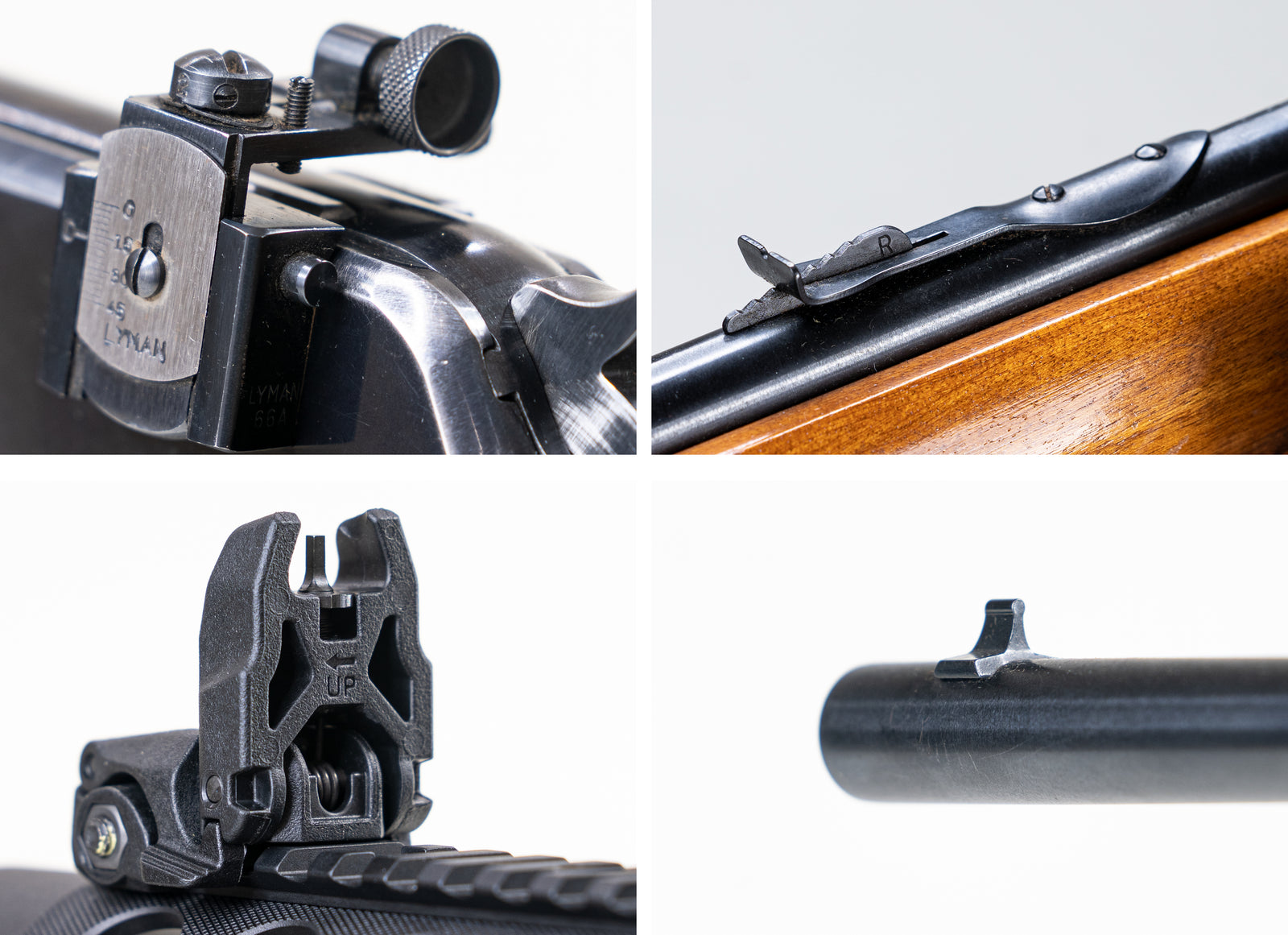Often one of the most contentious terms in firearm lingo - the magazine.
Your rifle should be capable of holding at least one round in a ready-to-fire position in the chamber. Once that round has been fired, the case needs to be ejected out of the way so another round can be fed into the chamber. Where does the next round come from?
The Magazine
If the rifle can hold multiple rounds that can be fed into the chamber one at a time, the rounds will be held in a container known as a magazine. The size and shape of the magazine will vary depending on the type of rifle. The capacity of the magazine (number of rounds it can hold) can also vary, depending on the magazine's physical size and the legal restrictions in your area.

One magazine in the rifle, another lying atop it with rounds ready.
Many modern rifles are fed from a detachable magazine. This is a boxy container made of plastic or metal with a spring inside. The spring pushes on a plate, trying to force it up towards the opening. Cartridges are stuffed into the magazine via the opening until it is full, or until you’ve reached the legal limit. As the rifle fires, the action performs a cycle of ‘clear out the last case, grab the rim of the next cartridge, push the cartridge up into the chamber.’ The spring and plate inside the magazine apply continual pressure against the stack of rounds from below, keeping them ready for the next time the action cycles. The upper edge of the magazine has a lip that keeps the rounds from spraying out like a snake in a can.
Your rifle, if it accepts magazines, will typically accept a particular shape and size. The rifle holds onto the magazine as best it can, and some designs do so better than others. If the magazine is too heavy (as in a Rambo-style drum magazine), it may simply fall out. If the magazine is the wrong size, it either won’t fit in, or will fall out.
During normal operation, your magazine works best if it stays in place and feeds without issue.The correct magazine should be the right size for your rifle, hold an adequate (though not excessive) number of rounds, and hold rounds that are the proper caliber and length for your rifle.

A series of different detachable magazines that all fit the same rifle.
This may seem like a confusing overabundance of options that need to be weeded through. Typically, though, the manufacturer will plainly state this rifle accepts this style of magazine. Then you can find who else manufactures that style of magazine, and pick the option that’s best suited for your uses.

Two styles of holding rounds in the magazine. At the end of the day, the one that fits your rifle is the right one for you.
The Tubular Magazine
Lever Action rifles will typically have a tubular magazine. I say typically, because there have been attempts in the past to make a lever-action rifle that takes a detachable magazine, while others have a magazine built into the buttstock.
A tubular mag sits below the barrel. It’s a second tube, often narrower in diameter than the barrel. Rounds are stacked tip-to-tail through the length of it. A spring at the front of the magazine pushes rounds backwards, where the lever action lifts them up into the chamber. The magazine may be loaded at the very front, if it has a sort of push-rod that needs to be removed. Otherwise it will load back at the receiver, where there will be a little window where rounds can be inserted (known as a King's Gate). In a very few rifles, the rounds are fed in at the back of the stock. In almost every situation, the rounds will be loaded so that the bullet faces the muzzle, just as it would be in the chamber.
Unlike the detachable magazines discussed before, tubular magazines are not meant to be removed. You’ll have just the one magazine for your rifle for the entire life of the firearm, provided nothing breaks. As a side note - I have a Henry rifle that wore down the plastic end of the ramrod after about 10 years. Beside that, the tube mag has had no problems.

An attached tubular magazine running below the barrel of an Henry H001. The rounds have been removed and laid out to demonstrate how they sit in the magazine. Below is the ramrod, which has a spring and plunger (orange) to push the rounds back toward the action.
Tube Mag Oddities
A bit of history - My favorite round is the .45-70(-405). It’s a hefty straight-walled cartridge with a few hundred grains of lead sitting at the front; 405 grains, to be exact. The bullet is .45 caliber, so nearly a half-inch in diameter. And it has 70 grains of black powder to propel it.
This round was developed in the latter half of the 19th century and has much higher amounts of recoil than you’d expect with modern rifles or modern cartridges. Back then, rifles were commonly either single-shot or lever-action. A problem formed that was unique to lever-action rifles: When multiple rounds of .45-70 were sitting in the tubular magazine, the tip of one bullet would be pressing against the primer of the next round. When the rifle was fired, the recoil would be strong enough that the bullet’s tip would act like a firing pin on the next round’s primer. Pull the trigger once, and the rifle might very well explode as all the rounds went off.
Another risk lay in the tubular magazine itself. The magazine has a spring at the front that constantly pushes rounds backward toward the action. When the magazine is empty, the user doesn’t actually need to fill the magazine completely in order for it to work properly. If only a few rounds are loaded before the spring is replaced, there’s a long gap that the spring must move through before pushing against the final round. If the spring is released onto the rounds too quickly, such as after catching on the lip of the tubular magazine during insertion, it could similarly hammer a primer down onto the next bullet.
As such, .45-70 rounds no longer have pointy tips. In fact, they often don’t even have rounded tips. The nose of the bullet is usually flat, to at least the full width of the primer. The recoil is exactly the same as in old .45-70 cartridges, but the waiting bullets no longer set off the next primer. Bullets intended for tubular magazines will rarely have a pointy tip. If they have a point at all, they’ll have a soft rubber tip.
Detachable magazines do not stack rounds in this way, so you can have pointy-tipped bullets and high recoil without your rifle becoming an explosive. The tip of the bullet simply presses against the inside wall of the magazine. At worst, it may scratch the magazine.

A 405 gr bullet with a flat nose, keeping the next primer relatively safe from impacts.
The Box Magazine
Some rifles, especially older bolt-action military rifles, will have a box magazine. This magazine is attached to the rifle permanently, not unlike the tubular magazine. It can hold multiple rounds, but cannot be easily swapped out for a fresh mag. Instead, rounds are stuffed into it. For the classic M1903 rifle, the bolt is retracted before rounds can be stuffed in from above. It will have a limited capacity, usually 5 to 8 rounds.

Pushing a round to the bottom of the box magazine, inside a Springfield M1903.
What is a Clip?
A clip differs from a magazine, though it should be mentioned here. Magazines are occasionally referred to as clips, which will surely raise someone’s hackles.
A clip is exactly what it sounds like: a clasp that holds a few rounds in an easy-to-manage group. Clips can sometimes be used to easily feed rounds into a magazine, but a clip does not have springs in and of itself. Rounds can be stripped off of the clip and forced into the magazine with the right sort of motion, leading some clips to be called stripper clips. Other clips, such as for the M1 Garand, are inserted into the rifle (the en-bloc clip) - but are also ejected from the rifle after the last round is fired, leading to a distinct pinging noise. A further difference - clips typically hold rounds by the rim, while magazines use spring pressure on the case to keep rounds in place. And, finally, a magazine will surround the rounds completely, while clips tend to hold only the rear end of the cartridge.
Long story short - 99% of the time, you’ll be talking about magazines for your rifle. If you have a very old rifle, there’s a chance you’re using clips to fill the magazine.
Please say magazine or ‘mag’ right now, to fix the word in your mind.

Two styles of clips, two styles of rifles. On the top, an M1903 being loaded from a stripper clip. The rounds are pushed down into the box magazine, then the clip is discarded. At the bottom, a Garand ejecting the clip after the last round is fired. The ‘ping’ sound is very satisfying.





Leave a comment (all fields required)